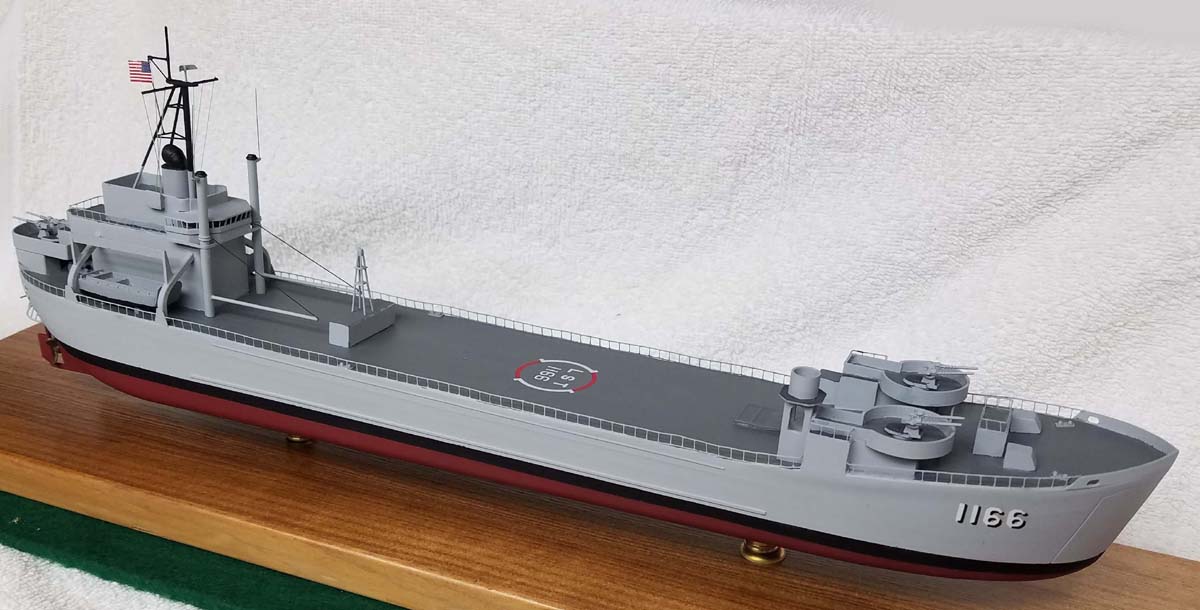
1/290 USS Washtenaw County (Lindberg)
|
by John MacKay |

1/290 USS Washtenaw County (Lindberg)
The Washtenaw County was one of 15 ships in the LST-1156 Terrebonne Parish Class. She was built by Christy Shipbuilding Corporation in Sturgeon Bay, Wisconsin, launched on 22 November 1952, and commissioned on 29 October 1953 in New Orleans. She served continuously in the Vietnam War from early 1965 to late 1971, receiving numerous awards and honors, including a Presidential Unit Citation. On 9 February 1973, she was converted to a Special Mine Sweeper and redesignated as USS Washtenaw MSS-2. After being decommissioned on 30 August 1973, she was operated in the merchant service for about 7 years. Some time after that, she was acquired by LST 1166 Partners with the goal of restoration into a museum ship. This endeavor failed and today, the ship is a derelict hulk on the Columbia River in Oregon.In August 2019, I was pleasantly surprised to be invited to attend the local reunion of the USS Washtenaw County, L.ST-1166. A friend, who had served on board both the USS Clarion River and the Washtenaw County, invited me and my wife as his guests and he generously paid for our banquet meals and various reunion fees. For this act of generosity, I wanted to pay him back, so I picked up the old Lindberg LST kit with the goal of presenting it to him at the reunion. At the time, I knew nothing about LSTs, aside from touring the LST-393 in Michigan several years ago. Since the Washtenaw County reunion was scheduled to start on 16 September 2019, I was going to be under the gun to get the model ready on time, but I assumed it would be a relatively simple conversion of the Lindberg kit into a reasonable replica. Boy, did I have a lot to learn!
Early on, I found that drawings of the Terrebonne Parish Class were not readily available; all of the drawings I found were for the LST-1 or LST-542 Classes. This was significant for two reasons: first, it meant Iíd have to work completely from photographs, which were mostly small and less than 50kb in size. Second, there were significant differences between the classes. The LST-1 Class was 328 feet long with a 50-foot beam. In contrast, the ships of the LST-1156 Terrebonne Parish Class were 384 feet long with a 55-foot beam.
The scale for the Lindberg kit is listed as 1/245th scale. Like other early Lindberg ship kits, having one consistent scale was apparently not considered important. Instead, the key factors appear to have been the size of the finished model and box size. This led to such odd scales as 1/245th. As with other early Lindberg ship kits, their LST kit still exhibits signs of being originally intended for motorizing.
Although LST-1 and -1156 Class ships were dimensionally different, their hull shapes look very similar outwardly, which meant the finished Washtenaw County model would be acceptable to everyone except the most picky rivet-counters. The kitís hull comes in one piece and this formed the basis for the model. When using the Lindberg kit hull, the greater length of the 1156 Class means the scale works out to approximately 1/290. The kitís deck had a large hole for the superstructure that wasnít going to work with the 1156 Class superstructure, so the entire deck was replaced with .040 inch styrene. The angle of the 1156 Class foredeck is less steep and longer and this was incorporated into the new deck. The topside structures and superstructure were constructed using various thicknesses of styrene. Masts were constructed using styrene and brass rod. The kitís screw guards were horrible, so I constructed new ones of styrene rod. The stern anchor stand was constructed using brass wire and styrene rod. I stole an anchor from a Revell LSM kit for use on this model, since the Lindberg anchors were terrible. I modified the kitís guns to cobble together 3 sets of 3Ē 50 Cal dual gun mounts. I painted the hull overall with Model Master Light Ghost Gray. The horizontal decks were painted Tamiya Dark Sea Gray. Boot topping was Model Master Flat Black. The red lower hull was painted using a homemade mixture. I used 1/144th scale brass ladders from Tomís Model Works for the lifeline railings. I used the kitís LCVPs after modifying them to be closer to scale size with creative filing and cutting. Hull numbers came from Scale Shipyard. The shipís name on the stern is a homemade decal. Although it is not quite correct, I used the helicopter landing pad decal from the kit. I removed the Ď325í numbers from the helicopter pad decal and inserted Ď1166í using Woodland Scenics dry transfer decals. The kit comes with both the WW2 48-star flag and the modern 50-star flag. The modern flag was used for this model. The model is anchored to the display base using screws passed through brass lamp couplings.
In the end, I almost ran out of time but managed to present the model to my generous friend on the night of 19 September 2019 at the reunion banquet. If I had had more time, I could have added additional details but as it turned out, I made some deliberate tradeoffs and omitted certain details in order to have the model ready on time. That being said, my friend was very grateful for the model and proudly showed it off to the other reunion attendees. My friend now wants to commission me to build a 1/144th scale model of the Washtenaw County, which would be 32 inches long. On the bright side, heís going to do all the legwork to get the shipís drawings Iíll need!
